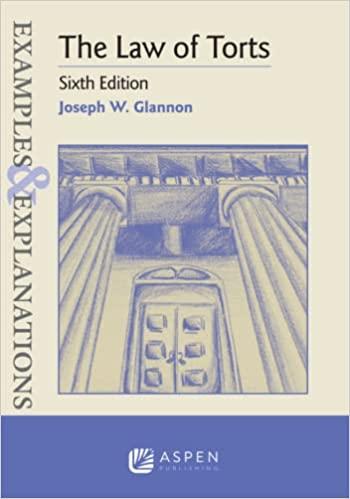Question
Explanation: The parties are most likely to make the following arguments: Rosie's heirs are most likely to argue that Nancy has no copyright interest in
Explanation:
The parties are most likely to make the following arguments:
Rosie's heirs are most likely to argue that Nancy has no copyright interest in the paintings because she did not create them and she is not Rosie's heir. They are also likely to argue that the paintings are not derivative works because they were not based on any of Beatrice's photographs.
Nancy is likely to argue that she has a copyright interest in the paintings because she contributed to their creation. She is also likely to argue that the paintings are derivative works because they were based on Beatrice's photographs.
The Cleveland Museum of Art is likely to argue that it did not infringe Nancy's copyright because the paintings are in the public domain. It is also likely to argue that it is entitled to display the paintings under the doctrine of fair use.
Sebastian is likely to argue that he did not infringe Nancy's copyright because the paintings are in the public domain. He is also likely to argue that his photographs are transformative because they are abstract and they comment on the paintings.
The legal support for those arguments.
Rosie's heirs are most likely to argue that Nancy has no copyright interest in the paintings because she did not create them and she is not Rosie's heir. They are also likely to argue that the paintings are not derivative works because they were not based on any of Beatrice's photographs. The legal support for these arguments would be that, under U.S. copyright law, only the creator of a work has a copyright interest in it, and that copyright interests are not transferable except by will or by contract. Additionally, the law provides that a derivative work is one that is based on one or more preexisting works, and that the copyright in a derivative work extends only to the material that is new and original. In this case, the paintings are not derivative works because they were not based on any of Beatrice's photographs.
Nancy is likely to argue that she has a copyright interest in the paintings because she contributed to their creation. She is also likely to argue that the paintings are derivative works because they were based on Beatrice's photographs. The legal support for these arguments would be that, under U.S. copyright law, a work is considered to be "jointly authored" if it is created by two or more people with the intent that their contributions be merged into inseparable or interdependent parts of a unitary whole. Additionally, the law provides that a derivative work is one that is based on one or more preexisting works. In this case, the paintings are derivative works because they were based on Beatrice's photographs.
The Cleveland Museum of Art is likely to argue that it did not infringe Nancy's copyright because the paintings are in the public domain. It is also likely to argue that it is entitled to display the paintings under the doctrine of fair use. The legal support for these arguments would be that, under U.S. copyright law, a work is in the public domain if its copyright has expired or if it was never copyrighted. Additionally, the law provides that the use of a copyrighted work for the purpose of criticism, commentary, news reporting, teaching, scholarship, or research may be fair use. In this case, the paintings are in the public domain because they were never copyrighted. Additionally, the museum is entitled to display the paintings under the doctrine of fair use because the display is for the purpose of criticism, commentary, news reporting, teaching, scholarship, or research.
Sebastian is likely to argue that he did not infringe Nancy's copyright because the paintings are in the public domain. He is also likely to argue that his photographs are transformative because they are abstract and they comment on the paintings. The legal support for these arguments would be that, under U.S. copyright law, a work is in the public domain if its copyright has expired or if it was never copyrighted. Additionally, the law provides that a work is considered to be transformative if it adds something new, with a further purpose or different character, and does not merely supersede the original work. In this case, the paintings are in the public domain because they were never copyrighted. Additionally, Sebastian's photographs are transformative because they are abstract and they comment on the paintings.
Information that the partner should attempt to learn from the parties and why that information will be significant to the outcome of any disputes that may arise. The partner should attempt to learn from the parties whether Nancy contributed to the creation of the paintings and, if so, to what extent. The partner should also attempt to learn from the parties whether the paintings are derivative works and, if so, whether they are based on any of Beatrice's photographs. The partner should also attempt to learn from the parties whether the paintings are in the public domain. The partner should also attempt to learn from the parties whether Sebastian's photographs are transformative. This information will be significant to the outcome of any disputes that may arise because it will determine who has a copyright interest in the paintings and whether the paintings are in the public domain.
Step by Step Solution
There are 3 Steps involved in it
Step: 1

Get Instant Access to Expert-Tailored Solutions
See step-by-step solutions with expert insights and AI powered tools for academic success
Step: 2

Step: 3

Ace Your Homework with AI
Get the answers you need in no time with our AI-driven, step-by-step assistance
Get Started


